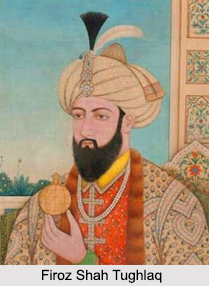 A Turkic Muslim ruler, Firoz Shah Tughlaq succeeded his cousin, Muhammad bin Tughlaq, one of the most controversial figures of Indian medieval history. The third ruler of the Tughlaq dynasty, Firoz Shah reigned over the Delhi Sultanate from 1351 to 1388.
A Turkic Muslim ruler, Firoz Shah Tughlaq succeeded his cousin, Muhammad bin Tughlaq, one of the most controversial figures of Indian medieval history. The third ruler of the Tughlaq dynasty, Firoz Shah reigned over the Delhi Sultanate from 1351 to 1388.
Rule of Firoz Shah Tughlaq
After the demise of Muhammad bin Tughlaq, Firoz Shah ascended the throne at the age of 45. His succession was faced with many rebellions and due to widespread unrest; his realm was much smaller than Muhammad"s. He was forced by rebellions to concede virtual independence to Bengal and other provinces like Gujarat and Warangal.
During his rule, Firoz Shah worked to improve the infrastructure of the empire. He did this by building canals, rest- houses and hospitals, creating and refurbishing reservoirs and digging wells. He also founded several cities around Delhi, including Jaunpur, Firozpur, Hissar, Firozabad and Fatehabad and wrote his own autobiography called the "Futuhat-e-Firozshahi".
General Administration of Firoz Shah Tughlaq
Unlike Muhammad bin Tughlaq, Firoz Shah was indiscriminately benevolent and lenient as a ruler. He refused to re- conquer provinces that had broken away from Muhammad"s annexation. He stopped all kinds of harsh punishments such as cutting off hands and lowered the land taxes that Muhammad had raised.
Firoz Shah Tughlaq sought advice from the Ulemas and ruled as per the Shariat. He imposed a number of taxes like the Kharaj, Zakat, Kham and Jaziya, which was levied on the non- Muslim subjects, particularly the Hindus. He also imposed irrigation tax after getting it sanctioned from the Ulema.
Firoz Shah paid attention towards the internal affairs of his state and put forth the domestic policies for the betterment of the people and state. He abolished nearly 24 taxes which were, certainly, burdensome to the people. He also abolished a number of internal trade taxes which resulted in reduction of prices of goods and enhancement of trade. He adopted measures for improvement of quality of cultivation and better crops. The measures he adopted were successful and resulted in the growing prosperity of both the subjects and the state.
Firoz Shah`s administrative justice was based on Islamic laws. His religious policies were based on the pre-eminence of Islamic laws. He restored the privileges of the Qazis and was himself a scholar and patronised learning. Zia- ud- din Barani and Shams- i- Siraj Atif wrote their works under his patronage. Firoz Shah established a large library at the temple of Jvalamukhi which consisted of 300 volumes of Sanskrit texts. He encouraged education and learning and the literature of his time was influenced by Islamic faith.
Other Works of Firoz Shah Tughlaq
Some of the other popular works of Firoz Shah Tughlaq are the renovation of the Qutb Minar and replacing the top storey after it was knocked off due to lightning. He also set up one of the two Ashokan Pillars at Firozabad, which he removed from their original sites. He cut a canal from the Sutlej River in 1355 and the following year, excavated another canal from the Yamuna River to Hansi, near which he built the Hissar Firoza. He even established a city called the Firoz Shah Kotla in Delhi, which was unfortunately destroyed in the later period by other rulers.
Other than these, he also planted numerous gardens near Delhi, entrusted the construction of canals to skilled engineers, levied on the cultivators a special water rate and reclaimed large areas for cultivation. His works were well appreciated by the people but historians often described his rule as the greatest age of corruption in medieval India.
Legacy of Firoz Shah Tughlaq
The lenient attitude of the Sultan had strengthened the nobles but in turn had weakened the ruler"s position. So, after the demise of Firoz Shah Tughlaq in 1388, a war of succession broke out, coupled with nobles rebelling to set up independent states. The Mughal army had become weak, the empire had shrunk in size and his successor Ghiyas- ud- Din Tughlaq II could not control the slaves or the nobles. Firoz Shah"s tomb is located in Hauz Khas, New Delhi, close to the tank built by Alauddin Khilji.






































